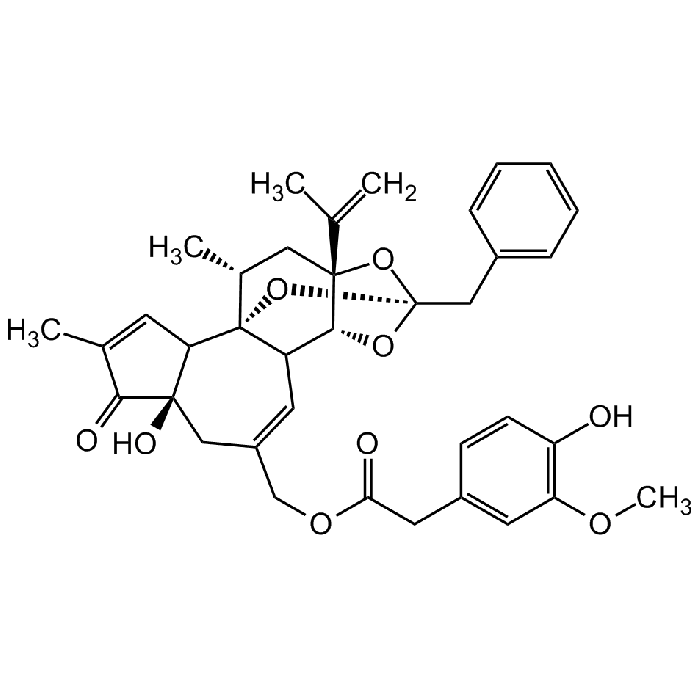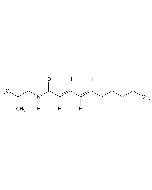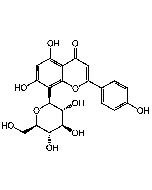Cookie Policy: This site uses cookies to improve your experience. You can find out more about our use of cookies in our Privacy Policy. By continuing to browse this site you agree to our use of cookies.
AdipoGen Life Sciences
Resiniferatoxin (high purity)

| Product Details | |
|---|---|
| Synonyms | RTX; MCP-101 |
| Product Type | Chemical |
| Properties | |
| Formula |
C37H40O9 |
| MW | 628.72 |
| CAS | 57444-62-9 |
| RTECS | CY1633700 |
| Source/Host Chemicals | Isolated from Euphorbia resinifera. |
| Purity Chemicals | ≥98% (HPLC) |
| Appearance | White to off-white solid. |
| Solubility | Soluble in DMSO (50mg/ml) or ethanol (25mg/ml). |
| InChi Key | DSDNAKHZNJAGHN-MSBCBURGSA-N |
| Smiles | CC(C1=O)=CC2[C@]1(O)CC(COC(CC3=CC(OC)=C(O)C=C3)=O)=CC4[C@]25[C@H](C)C [C@@]6(C(C)=C)[C@@H]4O[C@@](O6)(CC7=CC=CC=C7)O5 |
| Shipping and Handling | |
| Shipping | AMBIENT |
| Short Term Storage | +4°C |
| Long Term Storage | -20°C |
| Handling Advice | Keep cool and dry. |
| Use/Stability | Stable for at least 2 years after receipt when stored at -20°C. |
| Documents | |
| MSDS |
 Download PDF Download PDF |
| Product Specification Sheet | |
| Datasheet |
 Download PDF Download PDF |
- Highly potent TRPV1 agonist.
-
Resiniferatoxin (RTX) is a phorbol-related diterpene ester analog of capsaicin. RTX is a highly potent transient receptor potential vanilloid 1 (TRPV1) agonist (Ki=43pM) and acts as a selective modulator of primary afferent neurons. TRPV1 or vanilloid receptor 1 is a non-selective cation channel that is involved in the detection and transduction of nociceptive stimuli. TRPV1 is expressed in the plasma membrane of sensory neurons and stimulation by RTX causes this ion channel to become permeable to cations, especially calcium. The influx of cations causes the neuron to depolarize, transmitting signals similar to those that would be transmitted if the innervated tissue were being burned or damaged. This stimulation is followed by desensitization and analgesia, in part because the nerve endings die from calcium overload. Inflammation and nerve damage result in the up-regulation of TRPV1 transcription and therefore, modulators of TRPV1 channels are potentially useful in the treatment of inflammatory and neuropathic pain.
-
The primary action of RTX is to activate sensory neurons responsible for the perception of pain. RTX has been developed as an analgesic (painkiller) as a mean to provide pain relief for forms of advanced cancer. RTX has been investigated for treatment of urinary bladder hyper-reflexia, interstitial cystitis, rhinitis and chronic pain conditions. RTX has also been shown anti-inflammatory activity in T. spiralis infection, by inhibiting the Th1 immune response through the inhibition of Th1 cytokines in the intestinal phase.
-
Reduces myocardial ischemia-induced ventricular arrhythmias.
- Resiniferatoxin, a phorbol-related diterpene, acts as an ultrapotent analog of capsaicin, the irritant constituent in red pepper: A. Szallasi & P.M. Blumberg; Neuroscience 30, 515 (1989)
- Resiniferatoxin and its analogs provide novel insights into the pharmacology of the vanilloid (capsaicin) receptor: A. Szallasi & P.M. Blumberg; Life Sci. 47, 1399 (1990) (Review)
- Resiniferatoxin: an ultrapotent selective modulator of capsaicin-sensitive primary afferent neurons: J. Szolcsanyi, et al.; J. Pharmacol. Exp. Ther. 255, 923 (1990)
- Characterization of resiniferatoxin binding sites on sensory neurons: co-regulation of resiniferatoxin binding and capsaicin sensitivity in adult rat dorsal root ganglia: J. Winter, et al.; Neuroscience 57, 747 (1993)
- Euphorbium: modern research on its active principle, resiniferatoxin, revives an ancient medicine: G. Appendino & A. Szallasi; Life Sci. 60, 681 (1997) (Review)
- Differential activation and desensitization of sensory neurons by resiniferatoxin: G. Acs, et al.; J. Neurosci. 17, 5622 (1997)
- Selective and long-lasting neural blockade with resiniferatoxin prevents inflammatory pain hypersensitivity: I. Kissin, et al.; Anesth. Analg. 94, 1253 (2002)
- The effect of intravesical capsaicin and resiniferatoxin in neurogenic bladder dysfunction: A.S. el-Mahrouky, et al.; Adv. Exp. Med. Biol. 539, 359 (2003) (Review)
- Sensory nerve inactivation by resiniferatoxin improves insulin sensitivity in male obese Zucker rats: S.G. Moesgaard, et al.; Am. J. Physiol. Endocrinol. Metab. 288, E1137 (2005)
- Activation of transient receptor potential vanilloid 1 (TRPV1) by resiniferatoxin: M. Raisinghani, et al.; J. Physiol. 567, 771 (2005)
- Analgesic effects of capsazepine and resiniferatoxin on bone cancer pain in mice: L. Menendez, et al.; Neurosci. Lett. 393, 70 (2006)
- The vanilloid agonist resiniferatoxin for interventional-based pain control: M.J. Iadarola & A.J. Mannes; Curr. Top Med. Chem. 11, 2171 (2011) (Review)
- Therapeutic targeting of TRPV1 by resiniferatoxin, from preclinical studies to clinical trials: I. Kissin & A. Szallasi; Curr. Top Med. Chem. 11, 2159 (2011) (Review)
- Resiniferatoxin modulates the Th1 immune response and protects the host during intestinal nematode infection: J.L. Munoz-Carrillo, et al.; Parasite Immunol. 39, e12448 (2017)
- Molecular Influence of Resiniferatoxin on the Urinary Bladder Wall Based on Differential Gene Expression Profiling: E. Lepiarczyk, et al. Cells 12, 462 (2023)
- Natural Compound Isoliensinine Inhibits Stress-Induced Hair Greying by Blocking β2-Adrenoceptor: L. Yan, et al.; J. Clin. Pharm. Ther. 7238029 (2023)
- Thoracic Dorsal Root Ganglion Application of Resiniferatoxin Reduces Myocardial Ischemia-Induced Ventricular Arrhythmias: T. Yamaguchi, et al.; Biomedicines 11, 2720 (2023)









